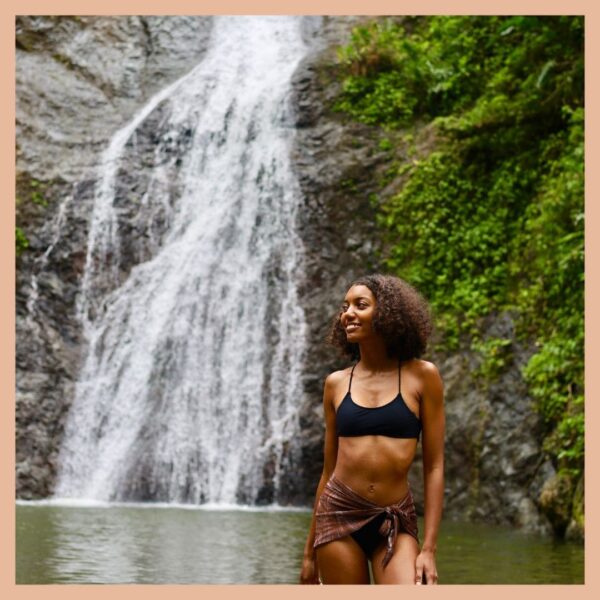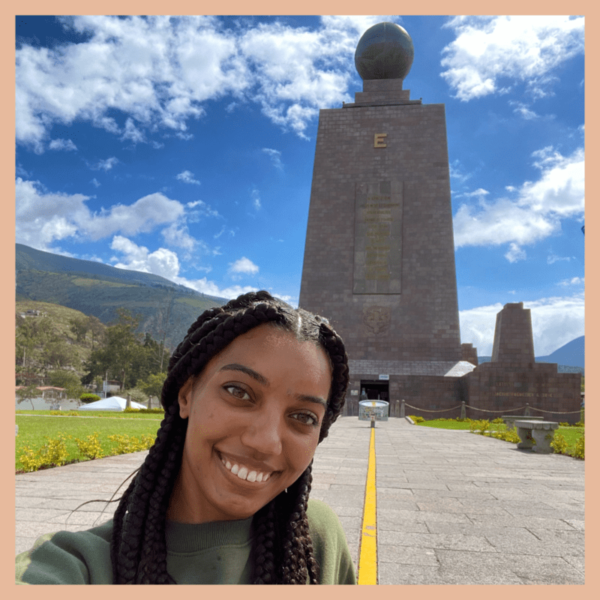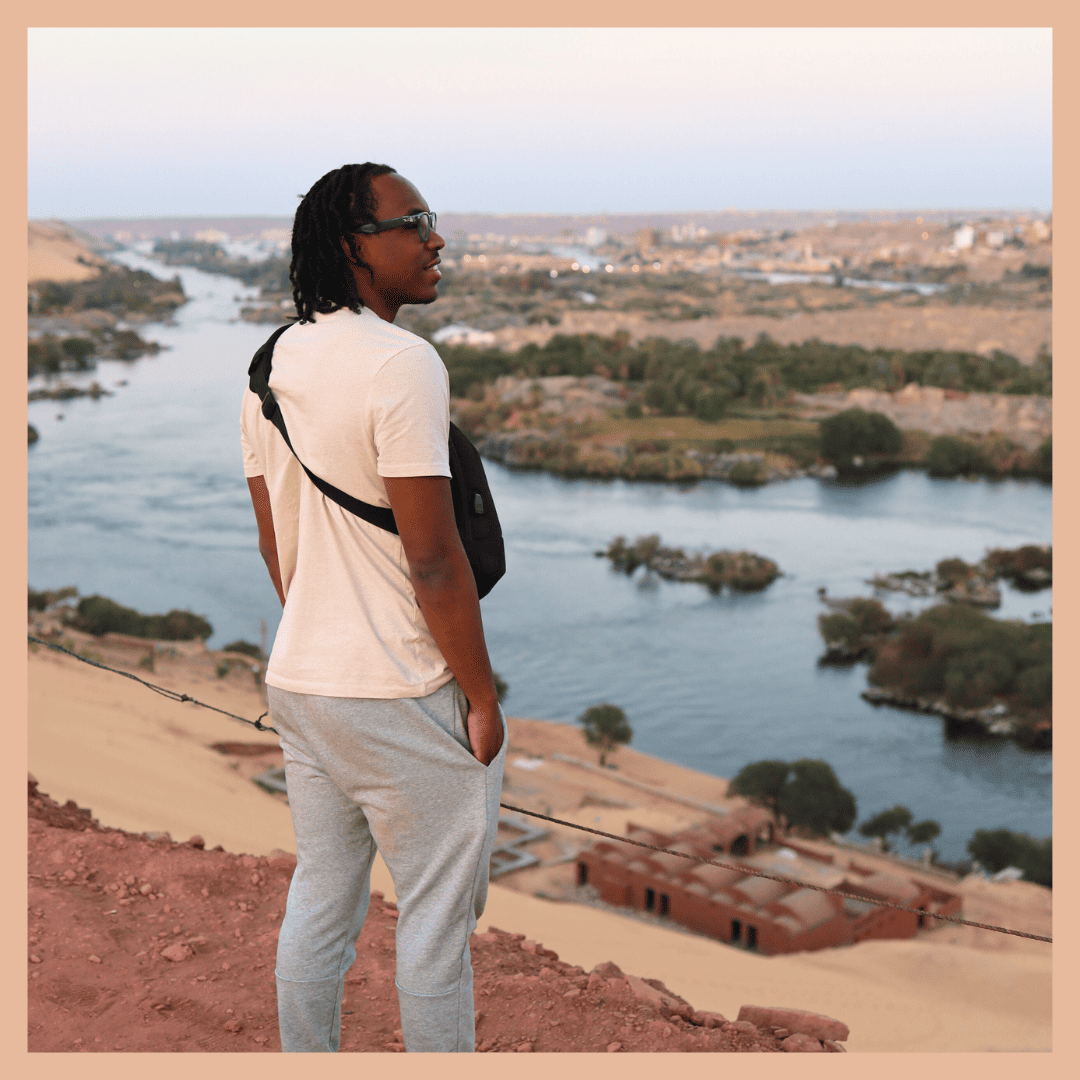
Experience Egypt differently—explore Aswan’s Nubian Village for bold flavors, vivid streets, and genuine connections you won’t find in the usual tourist spots.
Disclosure: This post may contain affiliate links, which means we’ll receive a commission if you purchase through our links, at no extra cost to you. Please read full disclosure for more information.
The Nubian Village in Aswan is a vibrant, colorful slice of Egyptian culture that’s come a long way in recent years.
My husband first visited seven years ago, back when the only way to reach it was by boat.
It was a quieter, more local experience back then.
But with the addition of a newly built bridge connecting the village to the rest of Aswan, getting there is now much easier.
The village itself has grown livelier, with colorful murals lining the streets and shops filled with handcrafted souvenirs.
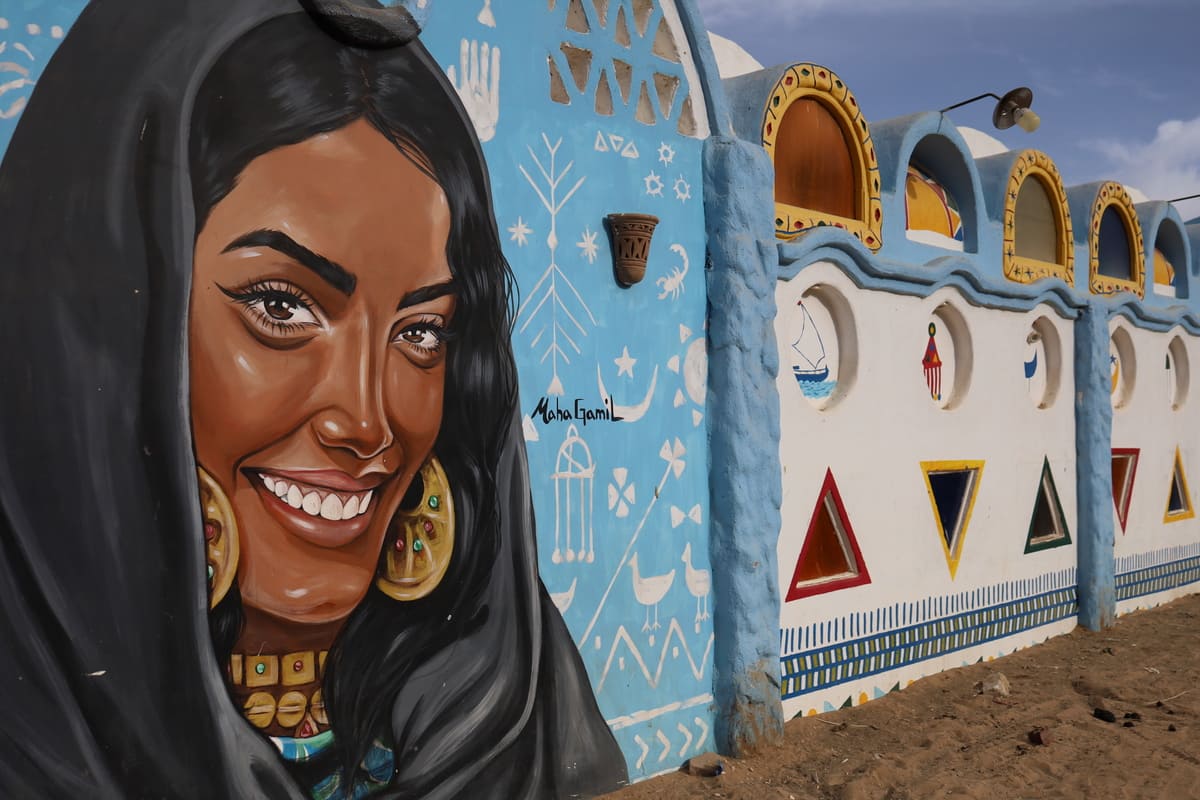
Compared to other markets in Egypt, the vibe here is more relaxed.
The locals will still offer their goods, but they’re far less pushy than the vendors you’ll find in places like Cairo or Luxor.
In this guide, I’ll share everything you need to know to plan your visit—how to get there, what to do, and how much to budget—so you can make the most of your time in this unique corner of Aswan.
History & Culture of the Nubian Village in Aswan
Aswan, located in southern Egypt along the Nile River, is known as the “Land of Gold”—a reference to its historical role as a gateway for trade and resources flowing between Nubia and ancient Egypt.
For centuries, Nubians, a distinct ethnic group with rich African heritage, have lived along this stretch of the Nile.
Known for their dark skin tones and vibrant culture, they’ve maintained their own language, customs, and traditions despite centuries of change.
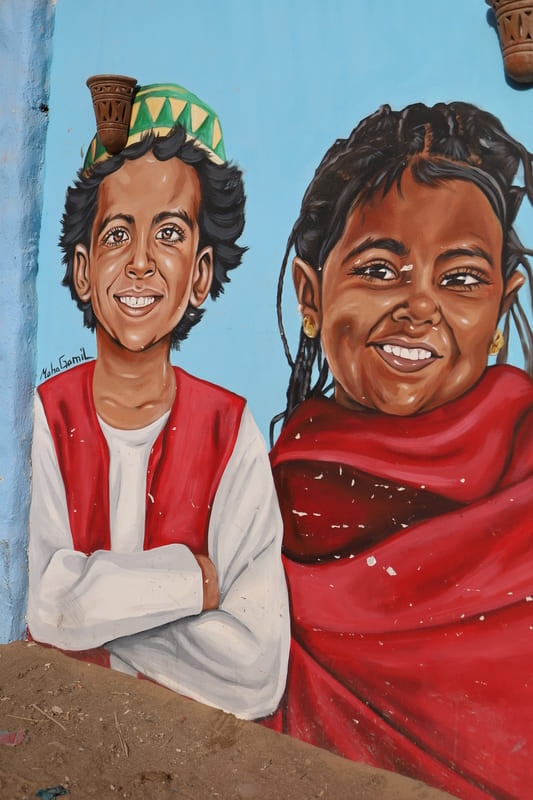
However, their history is also marked by displacement.
When the Aswan High Dam was built in the 1960s, much of Nubia’s ancestral land was flooded, forcing many Nubians to relocate to higher ground or newly built villages, like the one in Aswan.
The Nubian Village was once only accessible by boat, giving it a secluded, almost hidden feel.
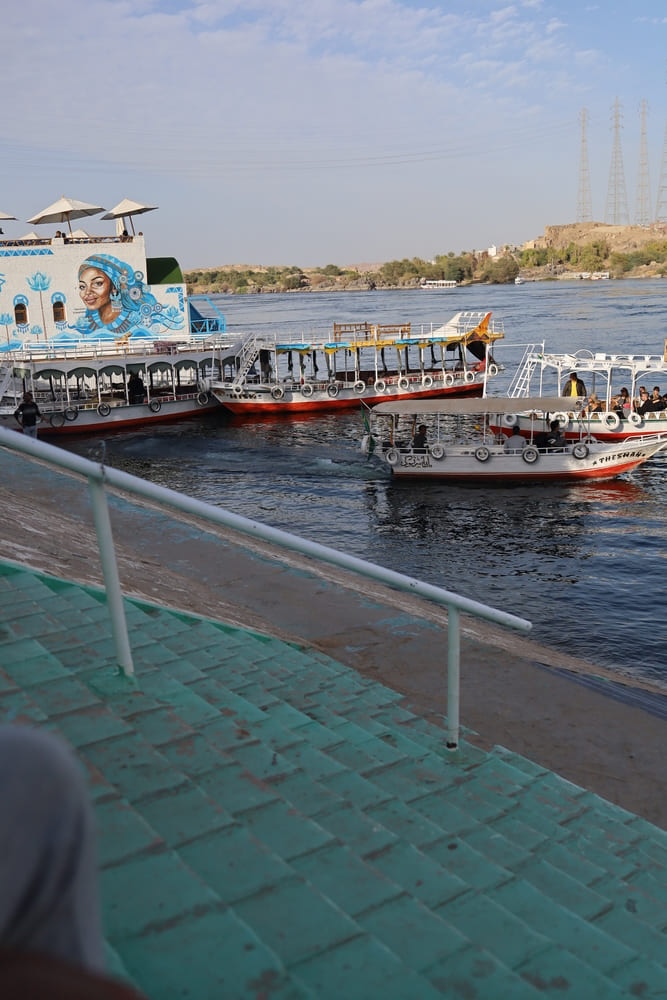
However, a newly constructed bridge now connects it to the rest of Aswan, making it easier for travelers to visit.
While some say the bridge has taken away a bit of the village’s mystique, it’s also brought more opportunities for locals to share their culture through tourism.
Getting to Aswan is straightforward, with options to travel by train, bus, or a short flight from Cairo.
We took a private car from Luxor to Aswan, which took about three hours and cost us roughly $50 USD.
On our return, we flew from Aswan to Cairo for $47 USD, and the flight took about an hour.
The Nubian people are known for their warmth, hospitality, and colorful homes painted with intricate, symbolic designs.
A visit to the village offers a rare chance to experience this resilient culture firsthand—one that has endured and thrived despite the challenges of time and displacement.
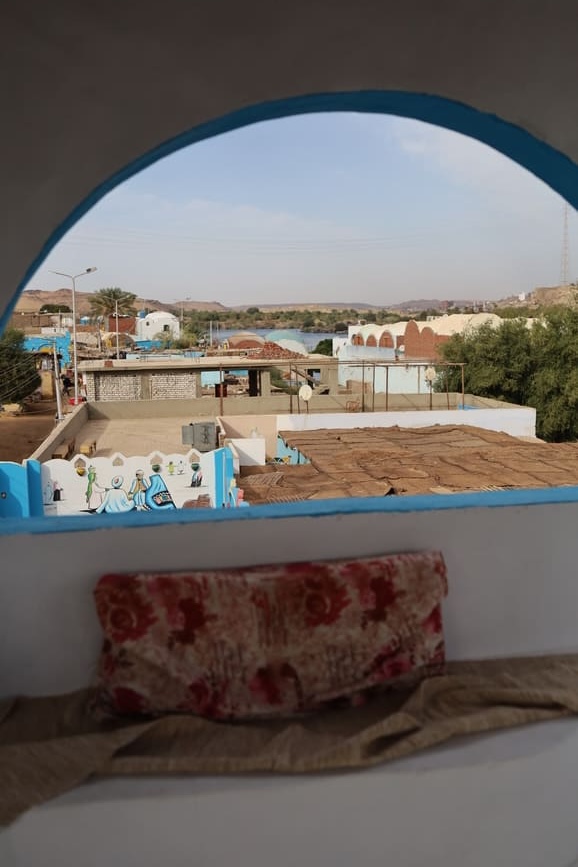
RELATED ARTICLE: Know Before You Go to Egypt
Tourism Market
The Tourism Market in the Nubian Village is one of the best places to shop in Egypt.
This colorful, lively stretch of shops offers spices, handcrafted jewelry, textiles, and souvenirs.
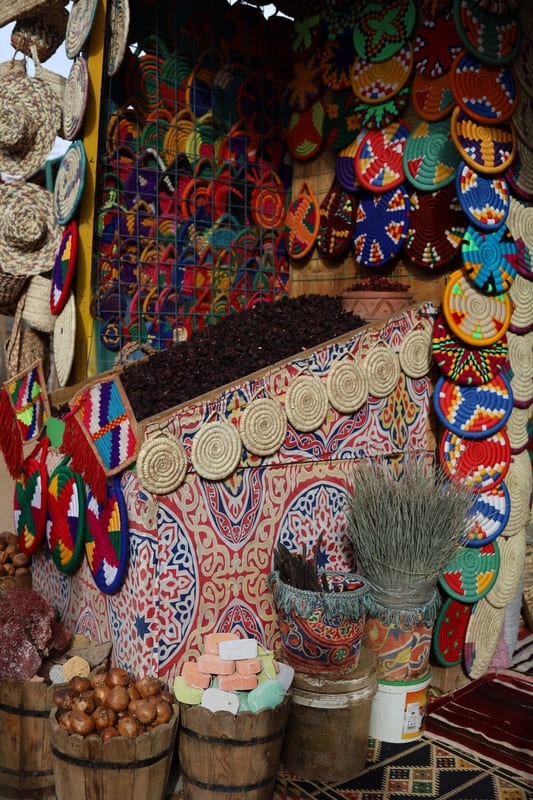
While similar items can be found throughout Egypt, the market here feels less hectic, and the sellers are more respectful of a polite “la, shukran” (no, thank you) compared to busier cities.
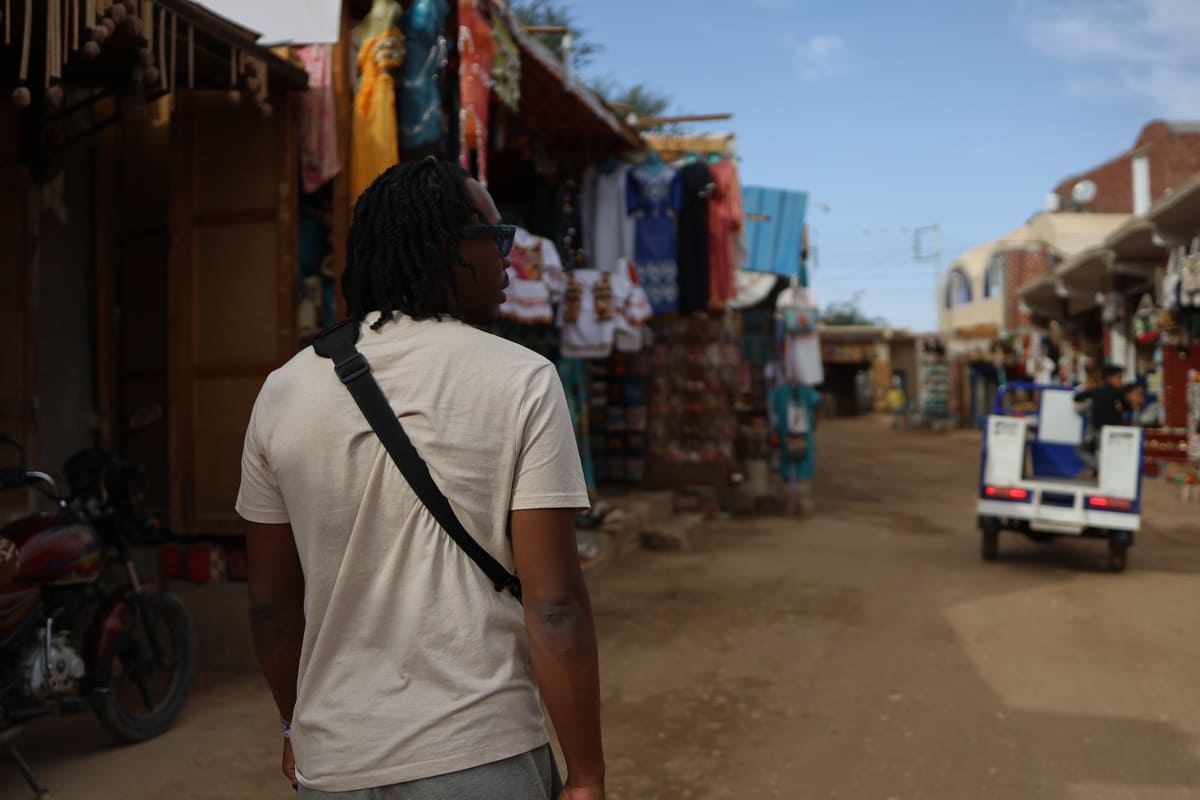
It’s not completely stress-free—it’s still a market, after all—but it’s a far more relaxed experience than shopping in Cairo.
RELATED ARTICLE: How to Reach the Top of Table Mountain
Where to Stay in Nubian Village
Lawanda Nubian Guesthouse
We booked a stay in the Nubian Village instead of Aswan’s main town at the last minute, and it was such a good choice.
Lawanda Nubian Guesthouse sits right on a corner of the Tourism Market, making it a perfect spot for exploring.
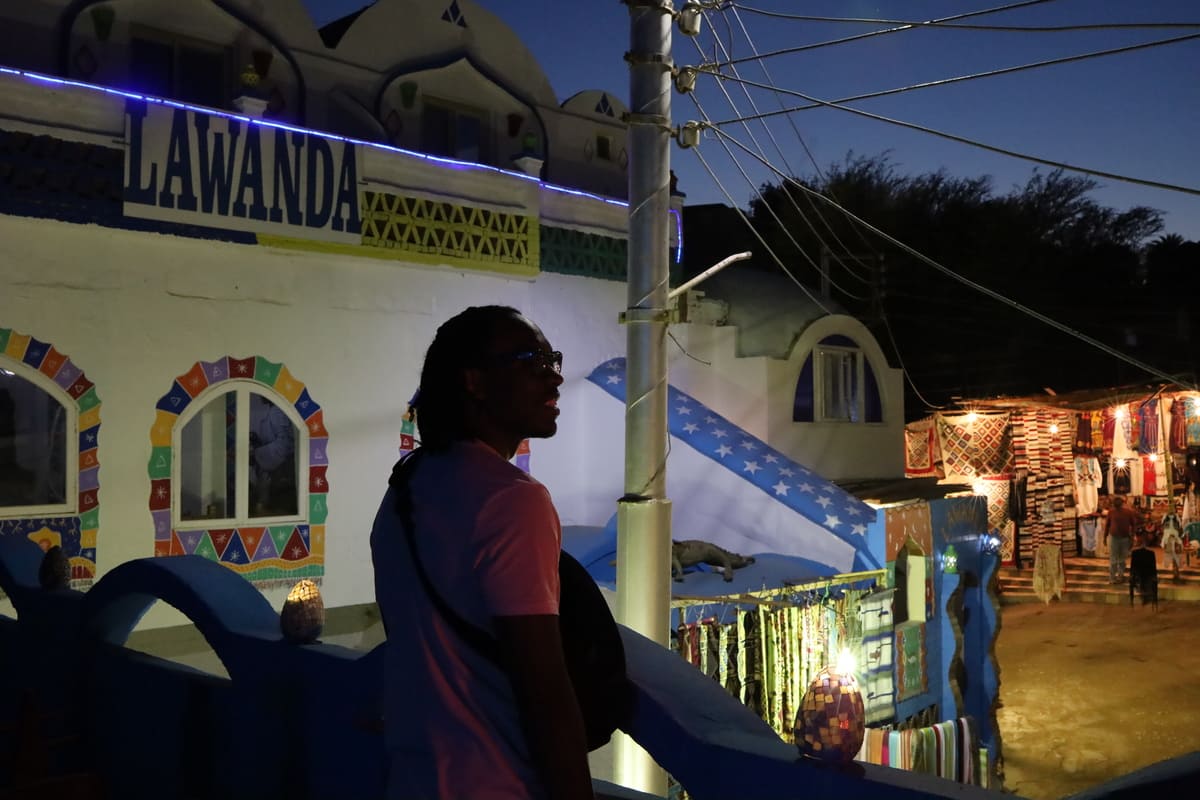
Whenever the market buzz felt overwhelming, we could quickly retreat to our cozy room.
Akhmed, the guesthouse manager, was a highlight of our stay.
He welcomed us with a refreshing glass of hibiscus tea—just the thing after a long journey—and shared insider tips on where to eat, shop, and explore.
The guesthouse itself is an art piece, with colorful murals and vibrant patterns decorating every wall.
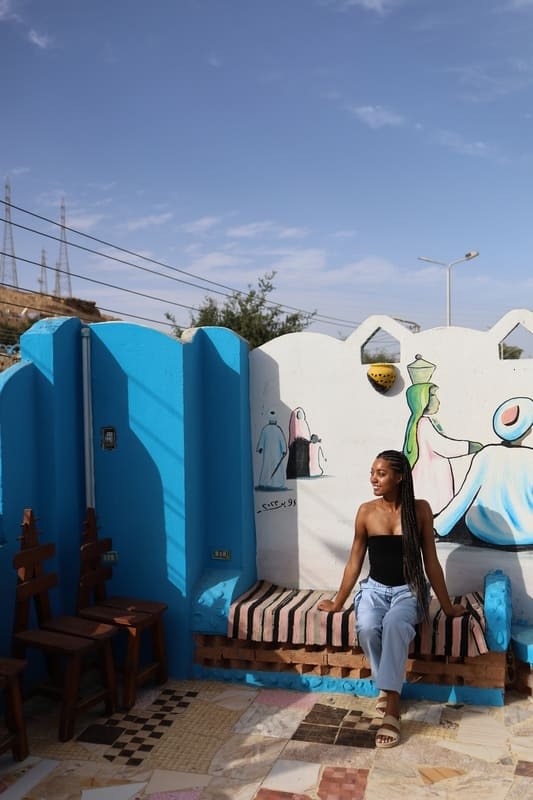
Our private room was clean and comfortable, but it’s worth noting that the private bathroom was a wet room style—meaning there was no separate shower stall, so water splashed around freely.
It was a bit surprising at first but easy enough to get used to.
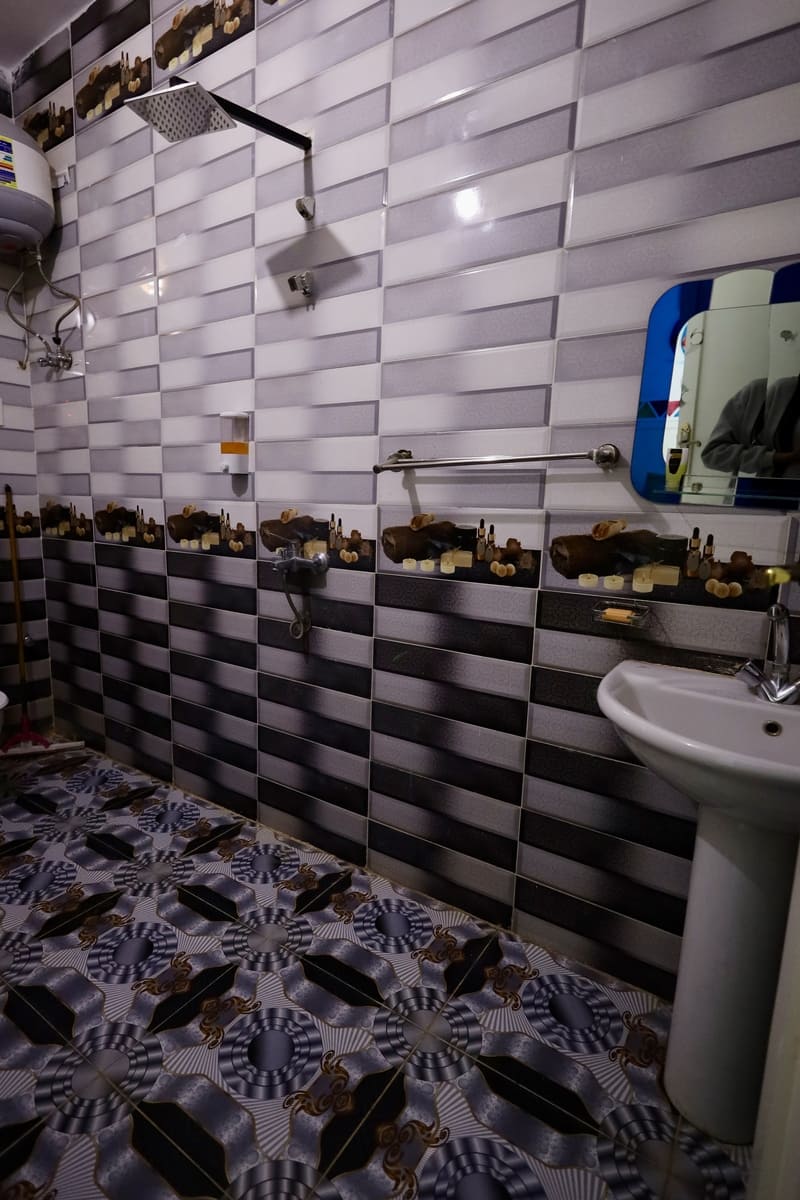
For under $20 USD per night, including breakfast, it was easily one of the best-value stays of our entire Egypt trip.
Lawanda isn’t a luxury resort, but it has all the charm and character you could hope for.
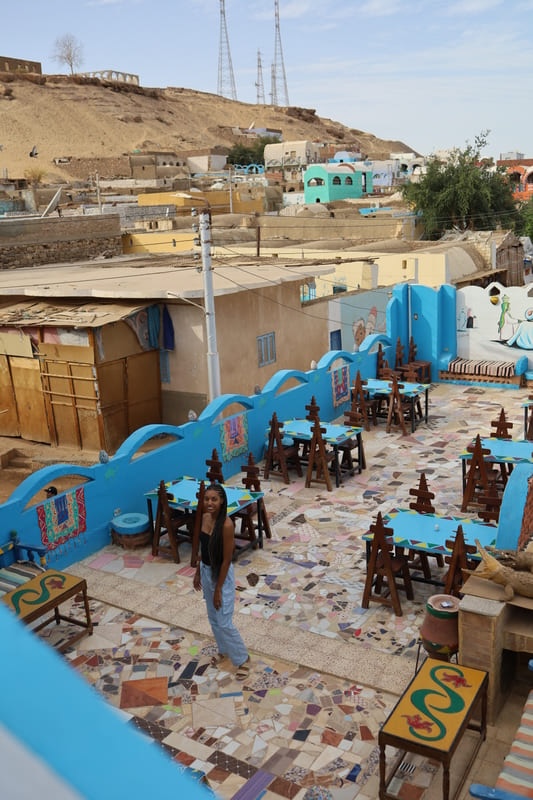
RELATED ARTICLE: Must Dos in Cape Town
Where to Eat in Nubian Village
Eating in the Nubian Village is packed with classic Egyptian flavors, vibrant surroundings, and warm hospitality.
Whether you’re craving slow-cooked tagines, creamy hummus, or a refreshing glass of hibiscus tea (a Nubian staple), the village’s restaurants deliver authentic dishes with a side of stunning Nile views.
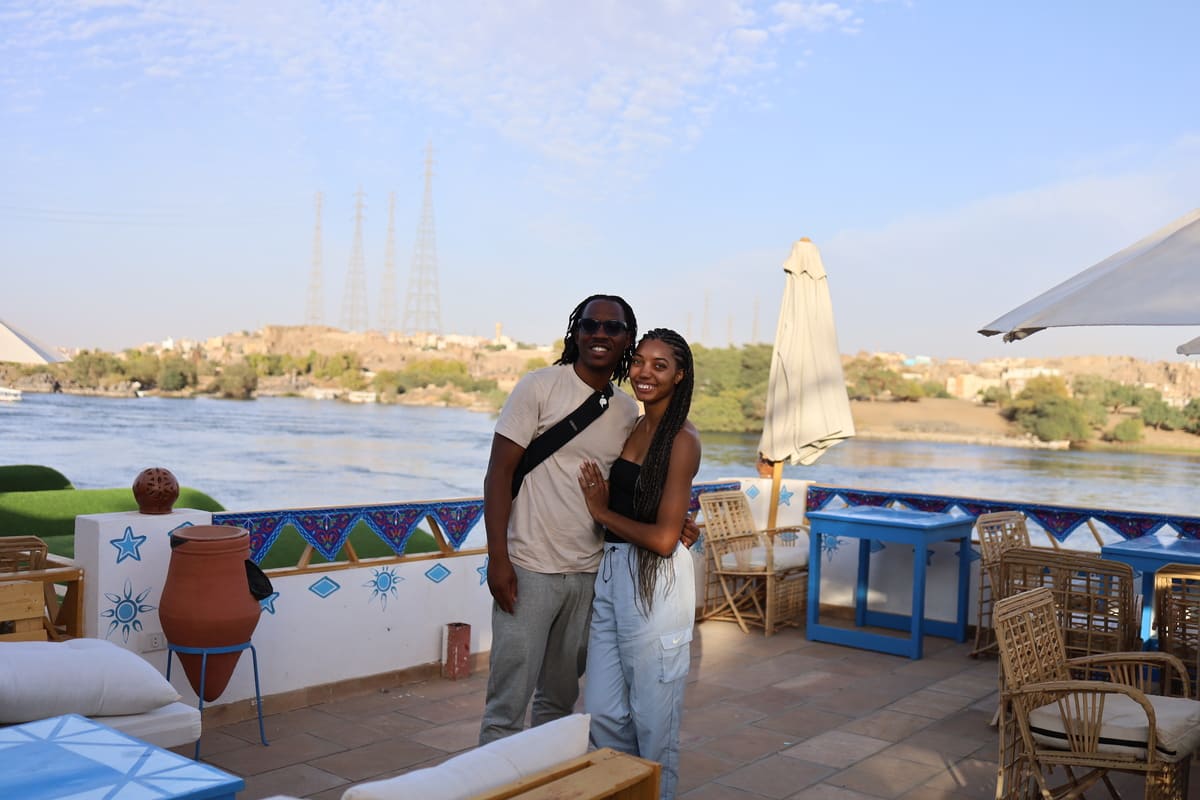
It’s the perfect place to slow down, enjoy generous portions, and soak up the laid-back vibe.
Dolty Kato Nubian House
If you’re looking for a cozy spot with riverfront views, Dolty Kato Nubian House is an excellent choice.
It’s right by the boat port, making it a popular stop for hungry travelers.
We ordered a spread of local dishes—flavorful, hearty, and packed with spices.
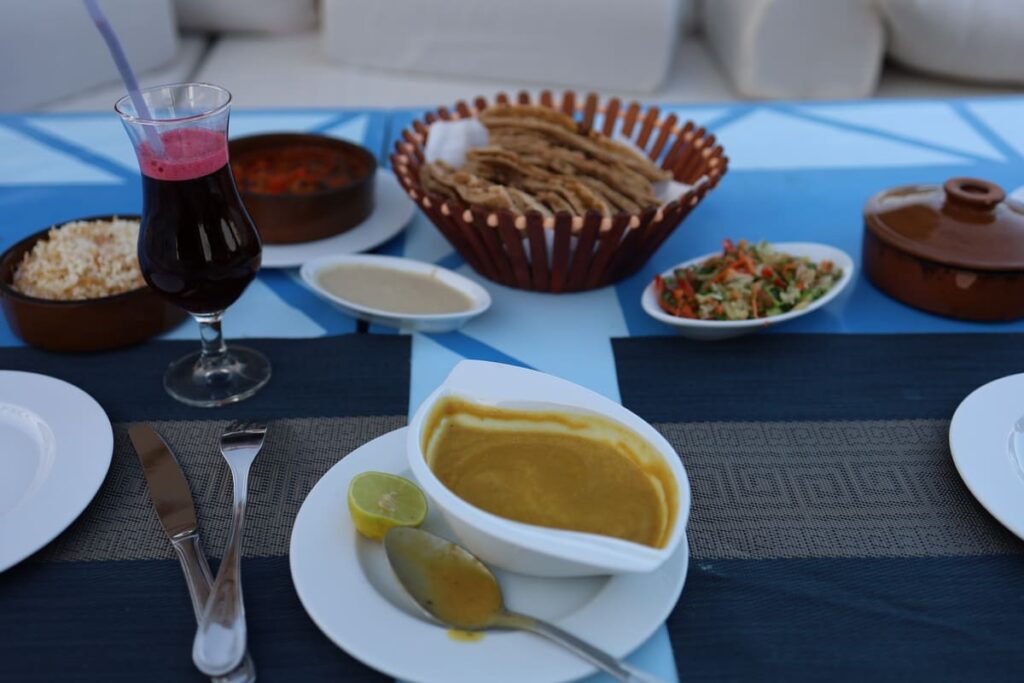
I enjoyed the potato tajine and lentil soup, while my husband had the chicken tajine.
It’s best to request any meats well done to ensure it’s cooked to your preference, as different cooking styles may vary.
The portions were generous, and while it’s slightly pricier than other options in the village, the atmosphere and view made it worth every Egyptian pound.
Our dinner only cost about $18 USD total, which felt like a steal given the quality and ambiance.
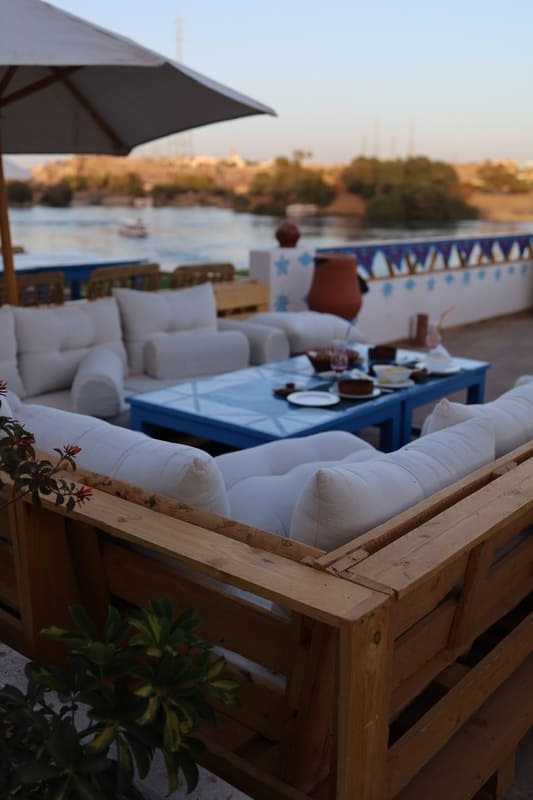
Doroka Nubian House
Just a short walk from Dolty Kato, Doroka Nubian House has an even more laid-back vibe.
When we visited, it was so quiet we had the entire place to ourselves.
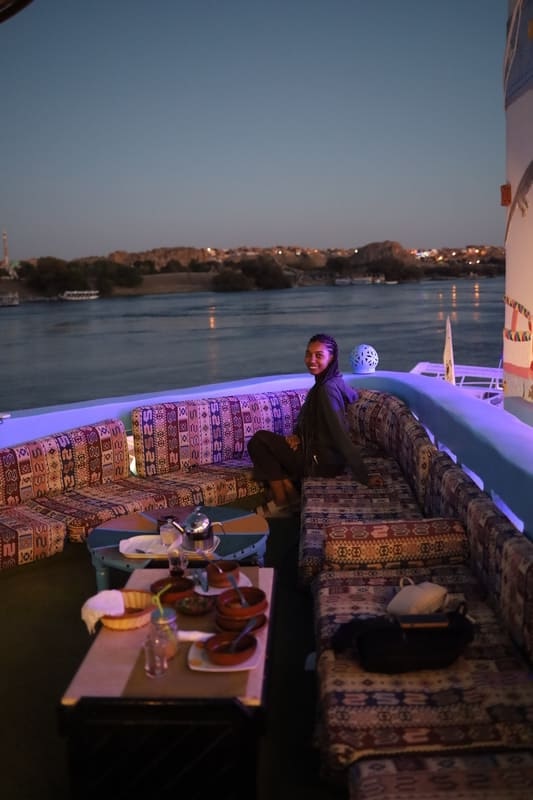
The setting felt super relaxed and intimate, making it a great spot for a private meal.
We tried some local specialties and were not disappointed.
I had the potato tajine and lentil soup, while my husband went for the fish tajine.
Both dishes were well-seasoned and filling.
Even better, the entire meal only cost around $10 USD for the two of us.
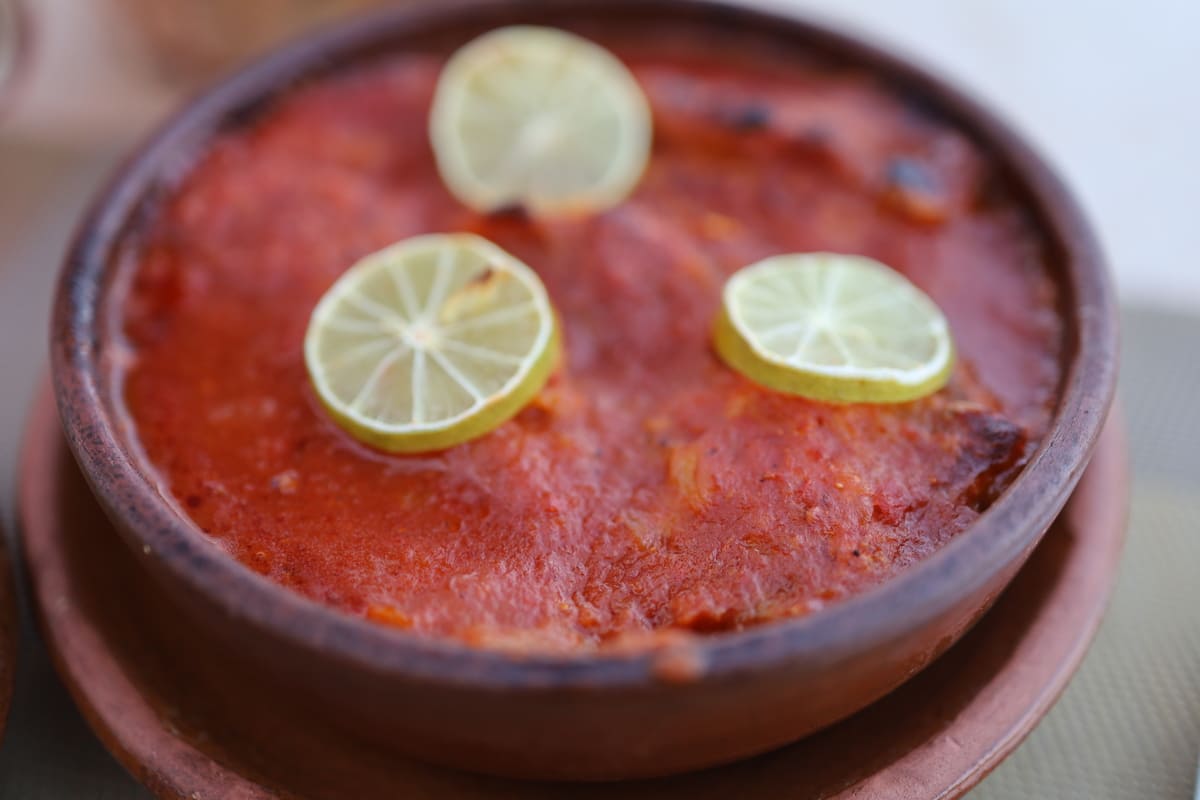
If you’re looking for a quieter, more low-key place away from the busier restaurants, Doroka is worth checking out.
The service was friendly, the food was tasty, and while the Nile views were nice, it was the calm atmosphere and budget-friendly prices that made this spot stand out for us.
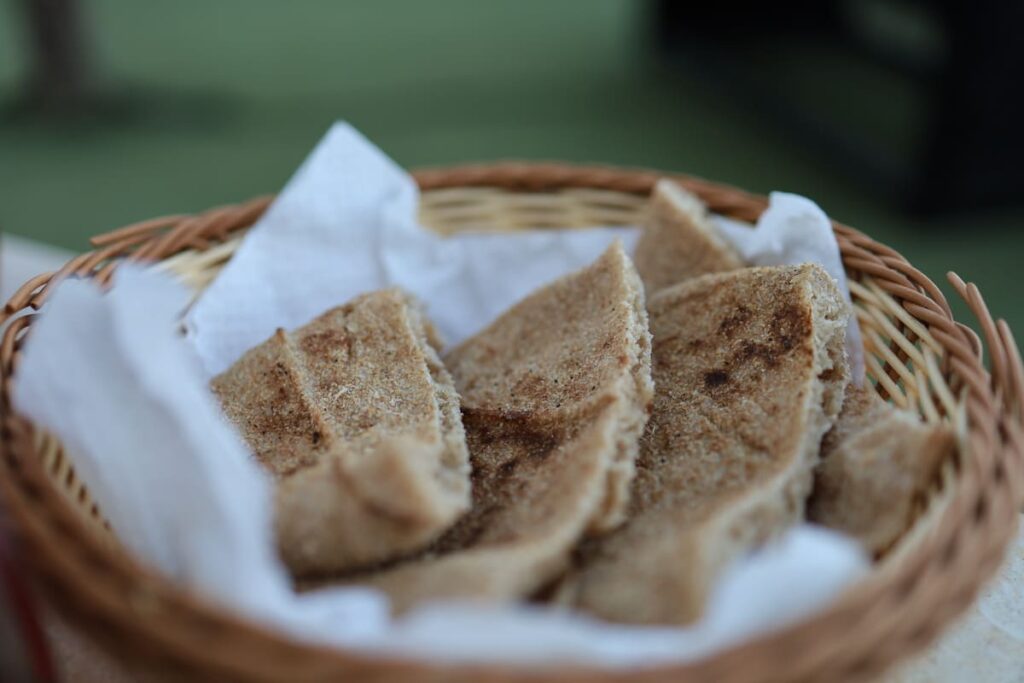
Abu Simbel
Visiting Abu Simbel was a long time coming for us. My husband had been wanting to take me here for years after visiting on a previous trip back in 2018.
Fun fact: when we got engaged in 2020, travel was still on hold, so instead of booking a flight, he built a pergola and patio in our backyard entirely on his own as the perfect place to propose.
I’m convinced he was channeling his inner Ramses II, inspired by this incredible temple.
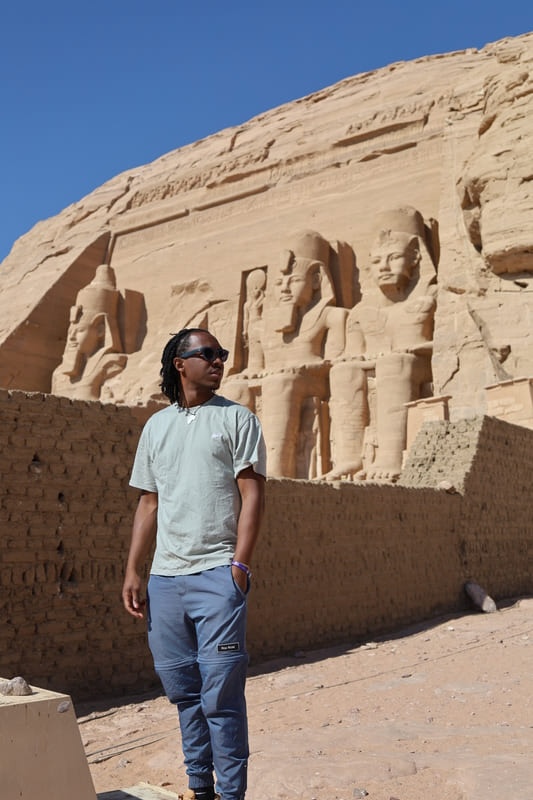
Getting There:
We joined a group tour that left around 4:30 AM from Aswan, and picked us up directly from our hotel in the Nubian Village.
The drive to Abu Simbel takes about four hours, which meant we arrived by 8:30 AM, explored for two hours, and left around 10:30 AM.
While the early departure meant we got there before the midday heat, it also meant arriving alongside a swarm of other tour groups.
The site was packed with hundreds of people, making it harder to fully admire the temples.
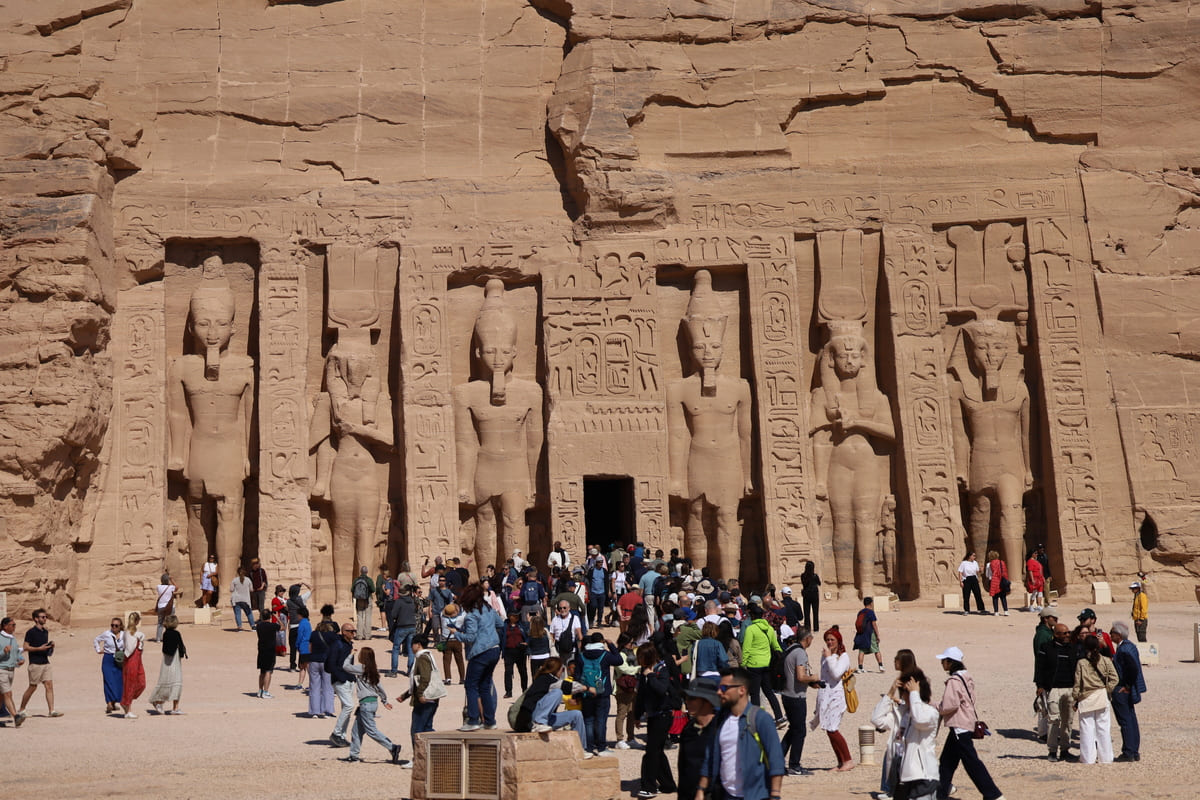
In hindsight, we would’ve preferred hiring a private driver and visiting later in the morning.
Most tours clear out by 10:30 AM, so arriving afterward would give you a much quieter experience.
The Experience:
Despite the crowds, Abu Simbel was still absolutely worth it.
The first thing you’ll see is the Great Temple of Ramses II, with its four colossal statues of Ramses carved into the facade.
Each statue stands about 66 feet (20 meters) tall, and even the smaller figures at their feet—representing his children—still tower over most people.
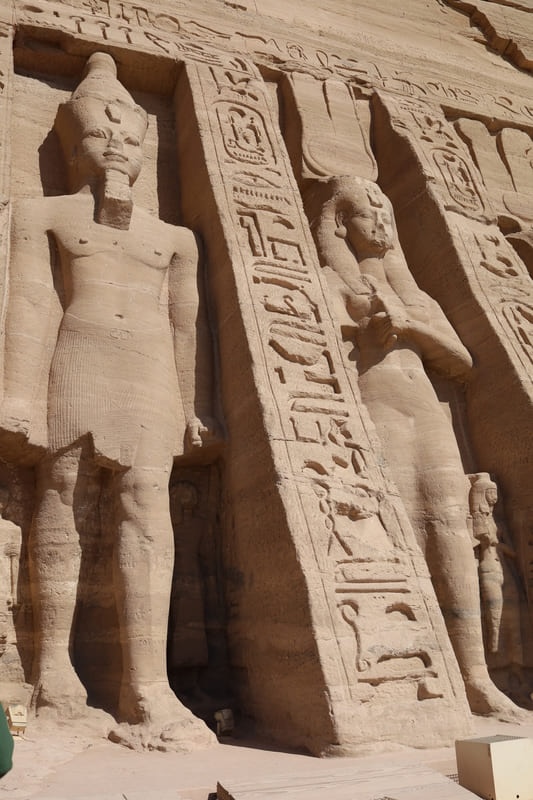
Next to it is the Small Temple, which Ramses dedicated to his wife, Nefertari.
Its facade features six statues—four of Ramses and two of Nefertari.
Seeing a temple built for a queen is rare in ancient Egyptian history, making this site even more special.
Inside both temples, the hieroglyphics are remarkably detailed, with intricate carvings covering the walls.
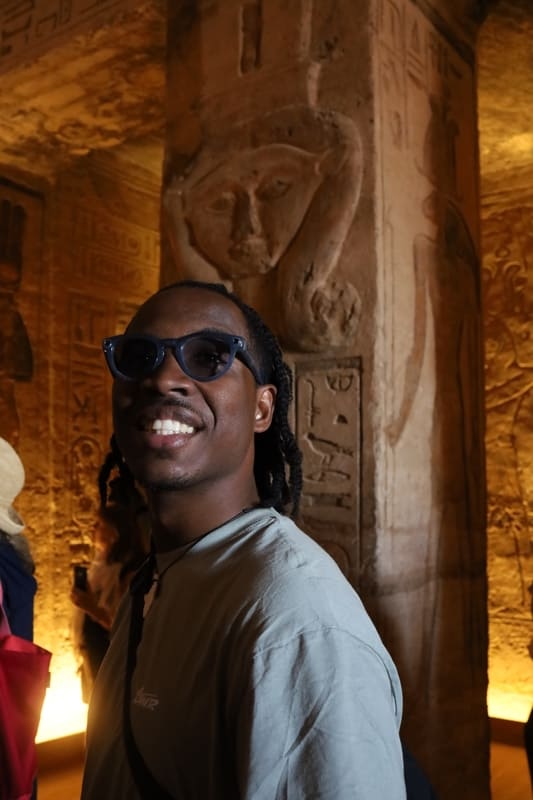
Outside, you’ll have gorgeous views of Lake Nasser, the largest lake in Egypt.
Chew Tip:
What’s even more impressive is knowing that Abu Simbel almost disappeared.
After the Aswan High Dam was built, rising water levels threatened to submerge the entire complex.
In a massive UNESCO-led project, the temples were carefully cut into thousands of blocks and relocated piece by piece to their current location.
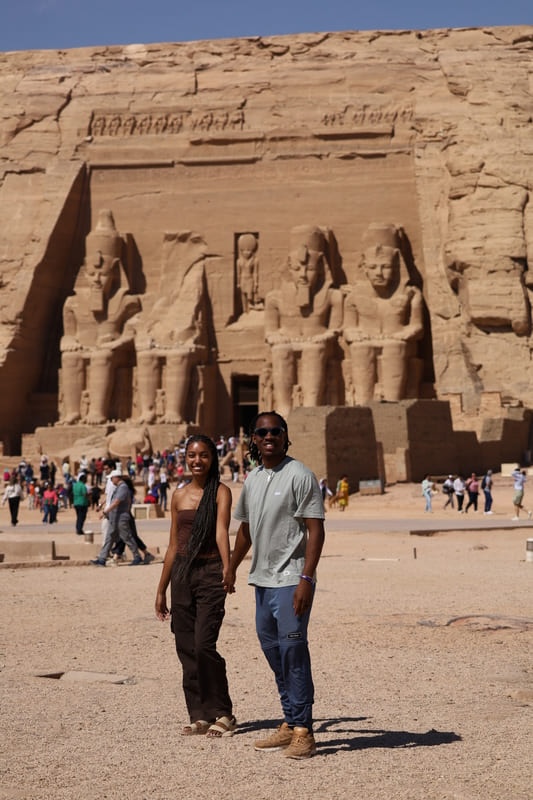
That level of preservation makes you appreciate seeing Abu Simbel in person even more.
How Much to Budget:
- Group tour: Around $25 USD per person for transportation only (no guide included).
- Private driver: Prices vary, but expect to pay more for a private experience.
- Entry fee: 300 EGP (~$6 USD) per person, card only.
Philae Temple
Philae Temple is one of the most unique sites in Aswan, mainly because it sits on its own island.
To get there, you’ll need to take a boat across the water.
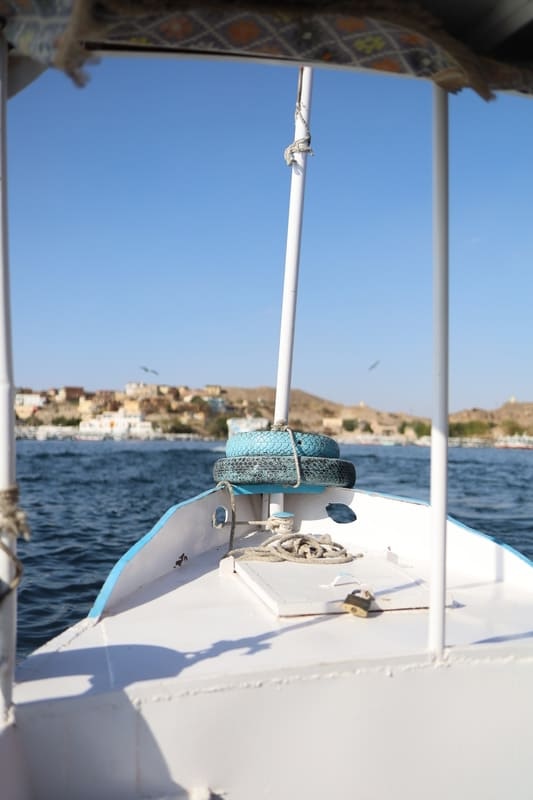
Getting There:
After buying your entry ticket (around 300 EGP/$6 USD per person, card only), you’ll head to the dock to negotiate a boat ride.
The boat fare is separate and paid in cash.
Boat drivers often quote around 300-400 EGP ($6-8 USD) per person for the round trip, but the price you pay depends on how many other people you have onboard.
Since the boats are privately rented, the fewer people you have, the more it costs per person.
To save money, try teaming up with other travelers.
We found another couple and negotiated the boat ride down to 150 EGP (~$3 USD) per person round trip, with one hour at the temple.
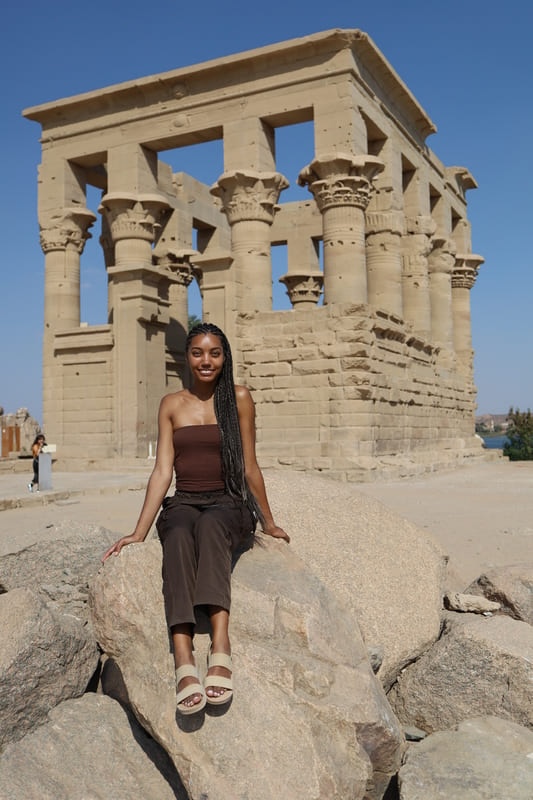
What to Expect:
The short boat ride offers scenic views of the temple rising from the water—making for a pretty grand first impression.
Once you arrive, you’ll find yourself walking through a beautifully preserved complex dedicated to Isis, the goddess of healing and motherhood.
The columns and walls are covered in detailed carvings and hieroglyphics, and you can explore the main temple along with smaller chapels and structures on the island.
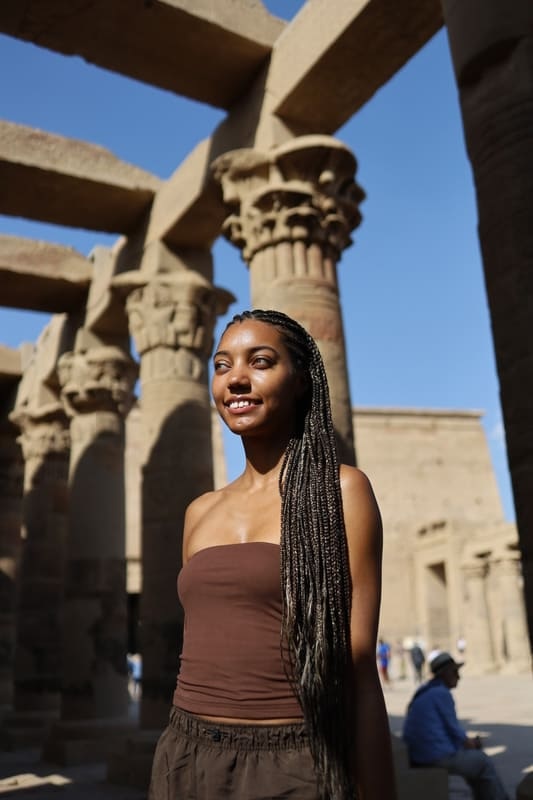
Chew Tip:
If you want a quieter experience, consider visiting later in the day when the crowds thin out. We went after returning from Abu Simbel and enjoyed having more space to explore without feeling rushed.
How Much to Budget:
- Entry fee: 300 EGP (~$6 USD) per person, card only.
- Boat ride: Around 150-400 EGP (~$3-8 USD) per person round trip, depending on group size and negotiation.
- Book a tour in advance: About $25 USD per person, including transportation and guide.
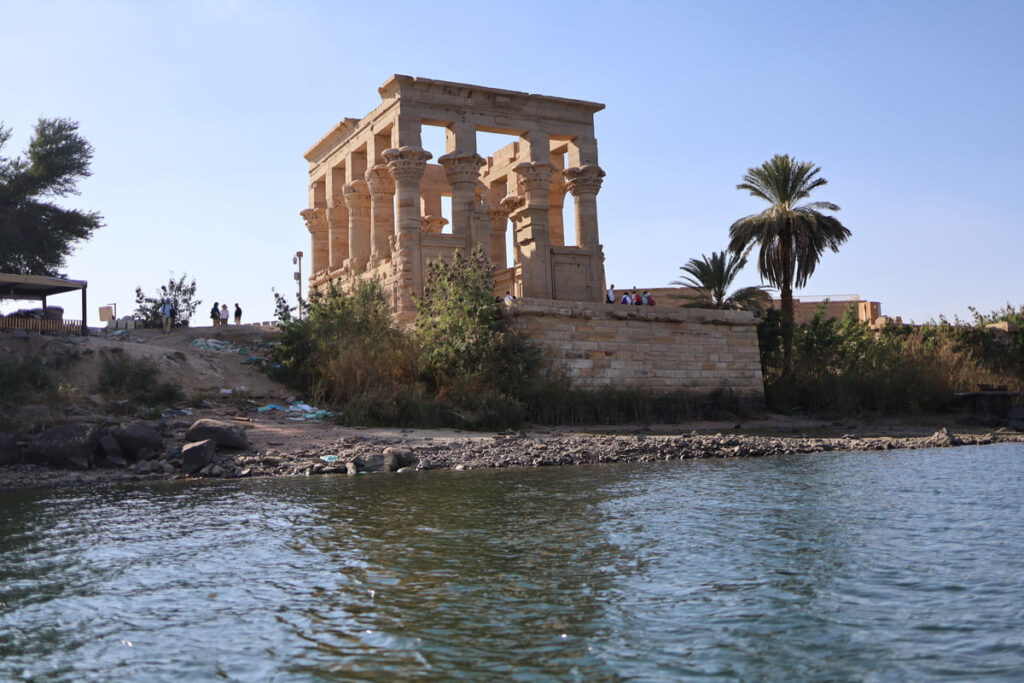
Elephantine Island
While we were on the boat to Philae Temple, we met some fellow travelers who highly recommended Elephantine Island and told us everything about it.
Getting there is easy—a short ferry ride from Aswan takes just a few minutes and costs around 10 EGP (~$0.20 USD) per person.
Just a heads-up: the ferry has separate sections for men and women.
The island itself has been inhabited since 3100 BCE and was once a key trade hub between Egypt and Nubia.
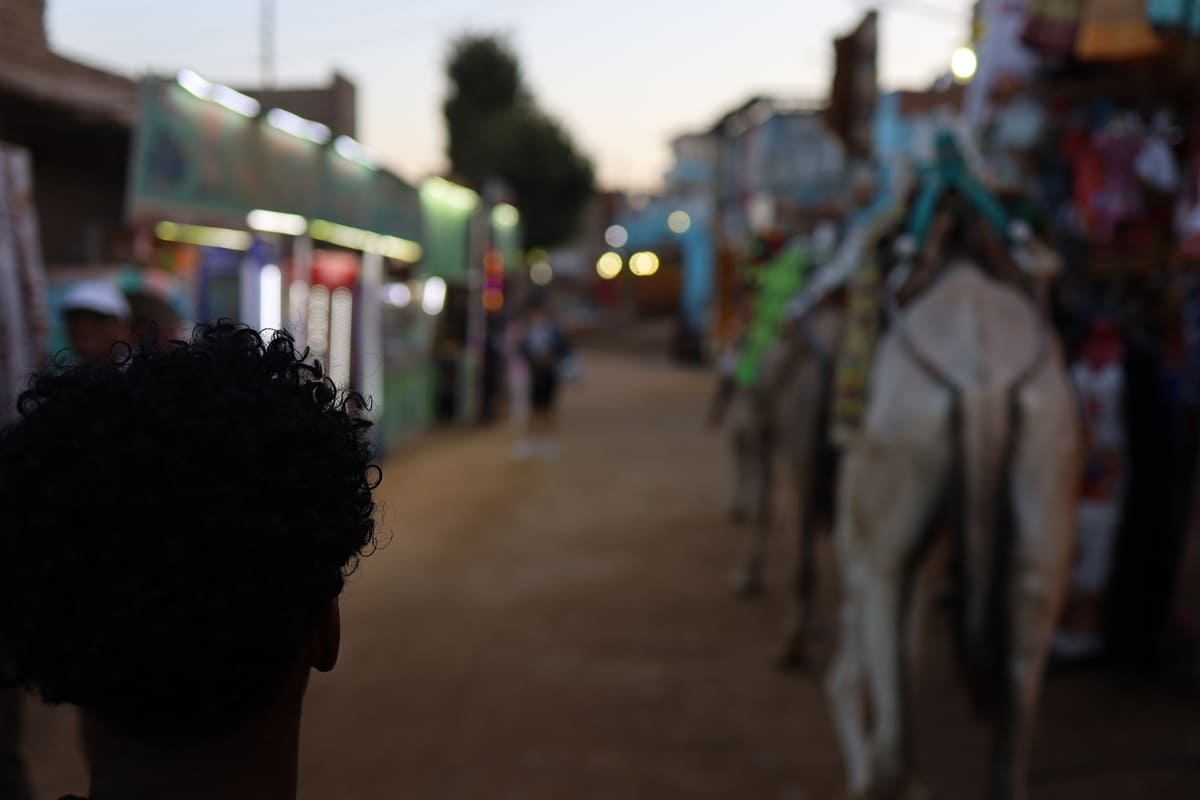
What makes it even more unique is that there are no cars—just narrow pathways and peaceful village life, giving it a much quieter vibe compared to the city.
At the southern tip of the island, you’ll find the Aswan Museum, which is worth visiting if you’re interested in the island’s long history.
Inside, you’ll see ancient pottery, tools, and everyday items from different eras, including Pharaonic, Roman, Byzantine, and Islamic periods.
Right next to the museum, you can explore the Temple of Khnum and the Temple of Satet, both small but significant ancient sites.
Nearby, you’ll also find the Nilometer, an ancient tool carved into the rock with markings used to measure the Nile’s water levels.
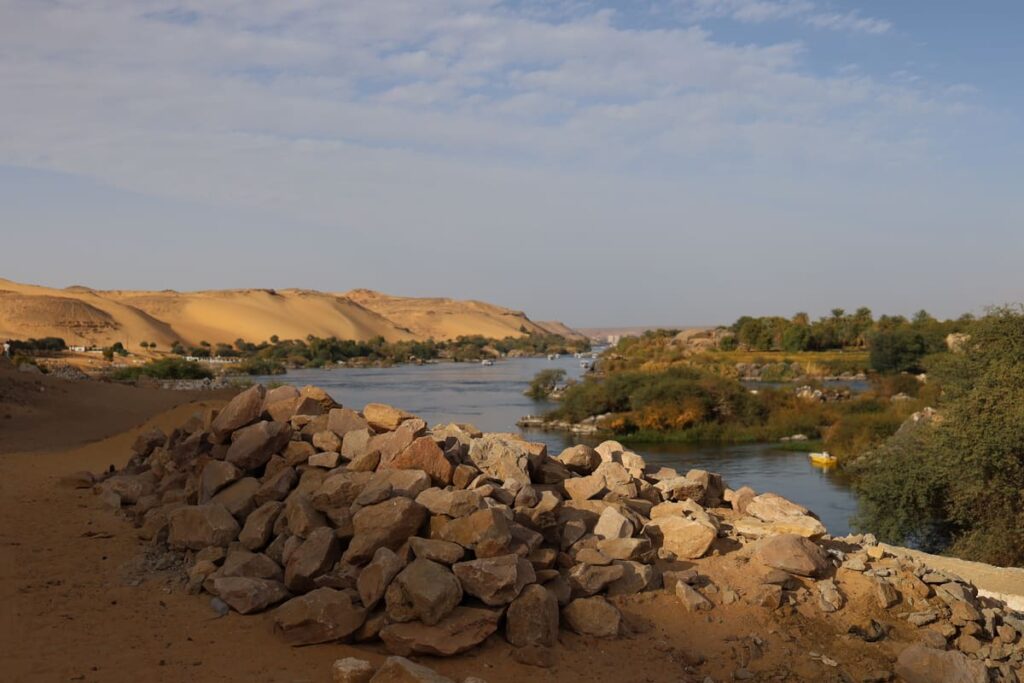
Back in the day, this was how they predicted annual floods and planned for the agricultural seasons.
How Much to Budget:
- Ferry ride: 10 EGP ($0.20 USD) per person.
- Museum and ruins entry: 200 EGP (~$4 USD) per person.
Sandboarding in Aswan Desert
While we first tried sandboarding in Huacachina, Peru, we were surprised to learn you can also do it right here in Aswan.
It’s a fun way to experience the desert landscape beyond just sightseeing.
Most tours take you out to the massive golden dunes near the Nile, where you can ride down the slopes on a board.
The views of the river and desert combined make it a pretty cool setting for this activity.
How Much to Budget:
- Tour prices: Vary depending on the group size and inclusions, but expect to pay around $30–70 USD per person if booking online.
- Booking tip: If you’re booking in person, just about everything is up for negotiation.
Abdogo Panorama Nile View
For one of the best sunset views in Aswan, Abdogo Panorama Nile View is a must-visit.
But fair warning—getting there is half the adventure.
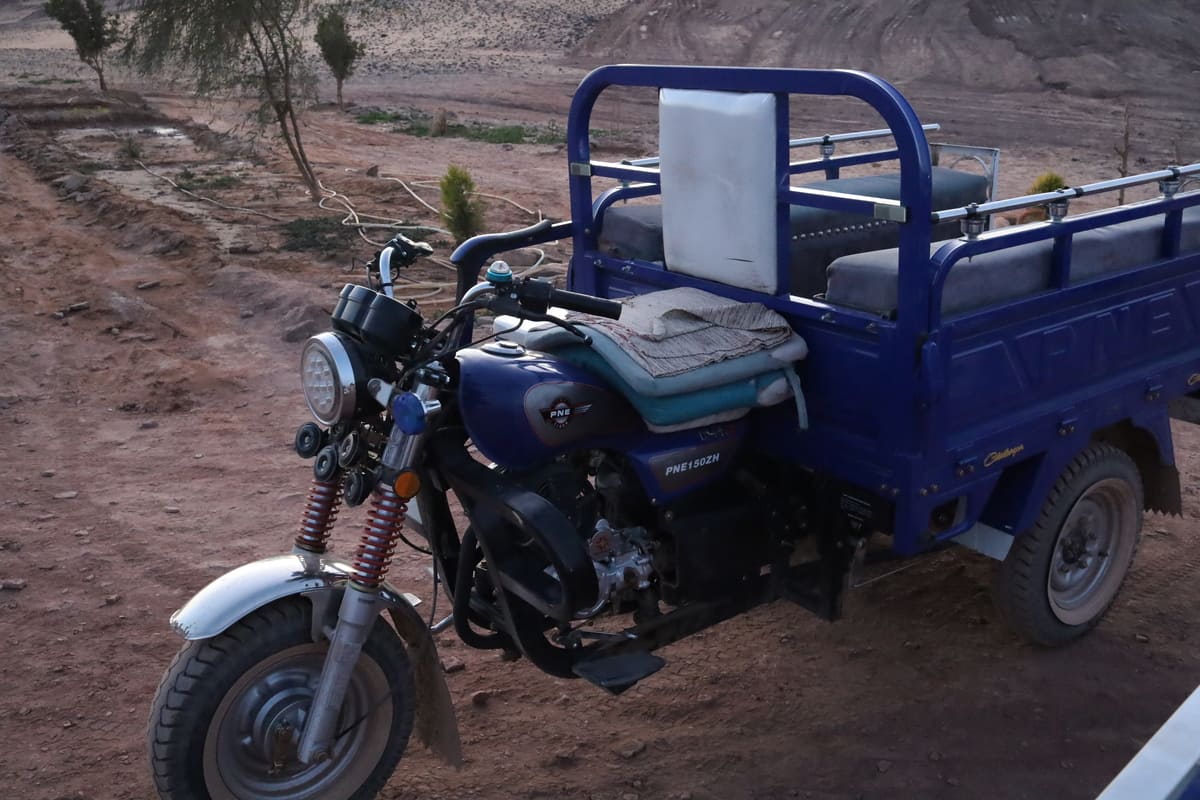
Getting There:
This spot isn’t walkable, so you’ll need to either take a tuktuk or ride a camel to reach the top.
We went for a tuktuk, which cost around $10 USD round trip. The ride itself was honestly one of the highlights.
Our driver had a big personality—cracking jokes, honking, and waving at every local we passed.
The lively ride made us feel like we were part of the neighborhood for a moment.
But make no mistake, it’s a bumpy ride.
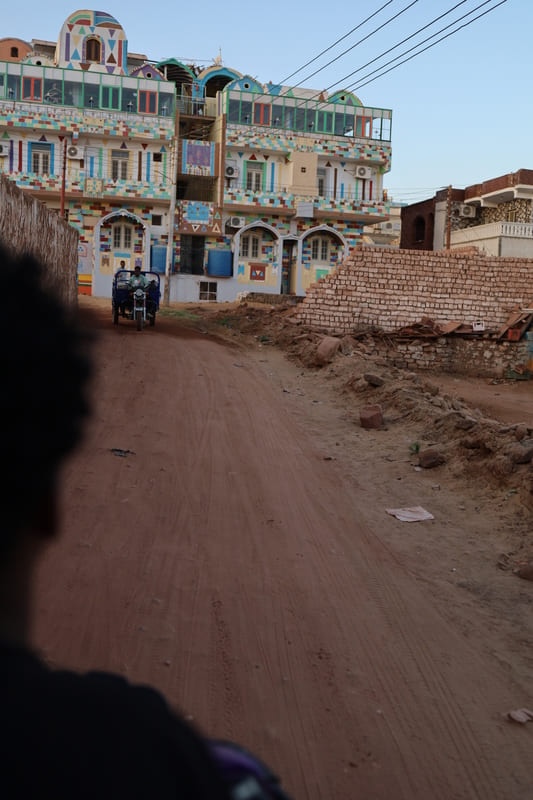
The gravel and sandy roads leading uphill are rough and uneven, so expect plenty of jolts along the way.
The Experience:
Once we arrived, the welcoming atmosphere made the ride well worth it.
Since we were visiting during Ramadan, we were greeted with dates and hibiscus tea to break the fast—a thoughtful and unexpected gesture that made the experience even more special.
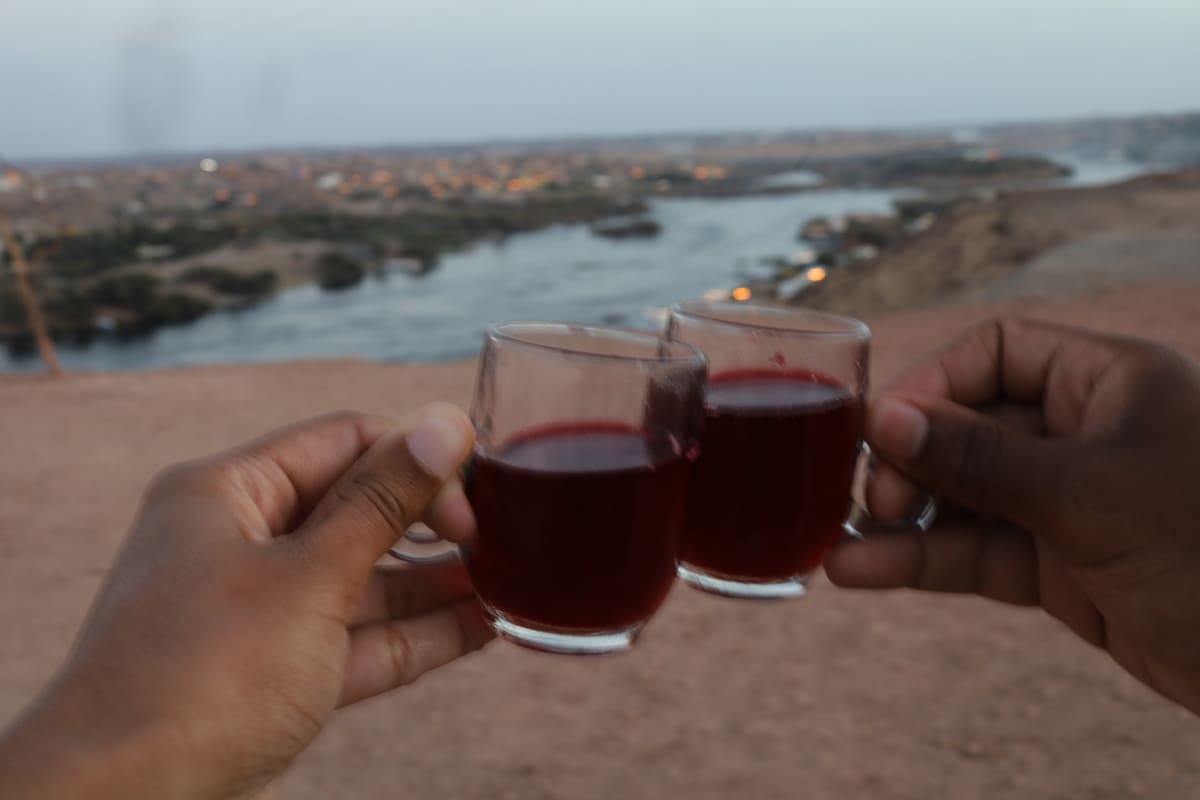
The view itself was breathtaking.
From the elevated terrace, you’ll get panoramic views of the Nile River winding between the desert landscape and colorful villages.
It was such a beautiful change of perspective to see the Nile from up here.
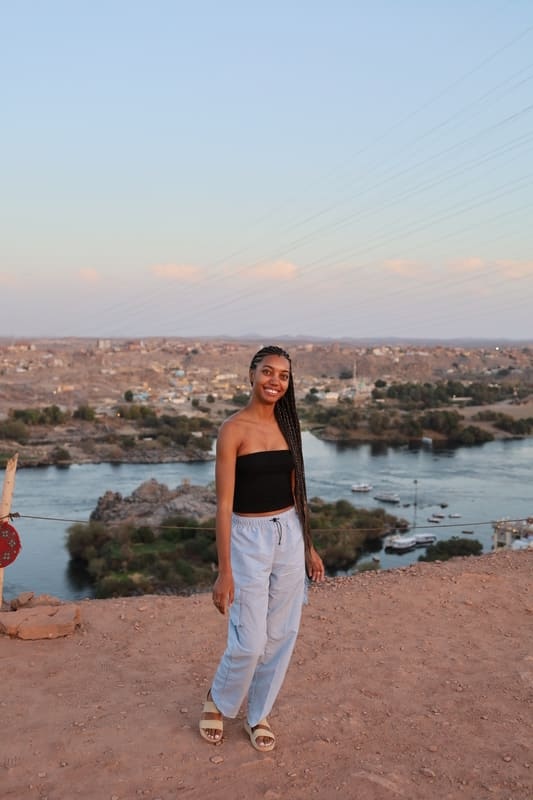
Chew Tip:
- Timing matters: Go about 30–45 minutes before sunset to find a good spot and enjoy the changing colors.
- Bring cash: The ride and any small purchases will require cash, as cards aren’t accepted.
How Much to Budget:
- Tuktuk ride: ~$10 USD round trip.
- Camel ride: Prices vary but expect to pay a bit more than the tuktuk ride.
- Tea: They offered us tea complimentary as a welcoming gesture.
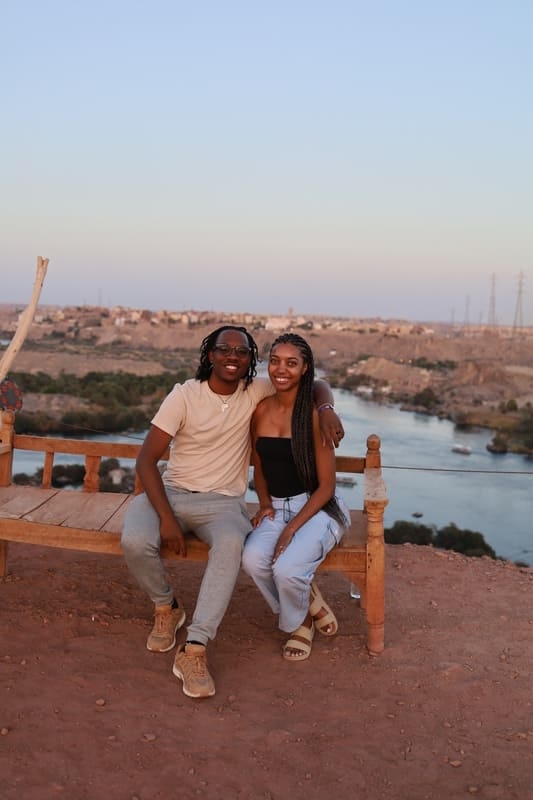
Felucca on the Nile at Sunset
Even though we did our felucca ride in Luxor, it’s just as popular—and just as scenic—in Aswan, especially near Nubian Village.
If you’re going to do a felucca ride in Egypt, sunset is the time to do it.
The temperatures are cooler, and the views over the Nile near Nubian Village are unbeatable.
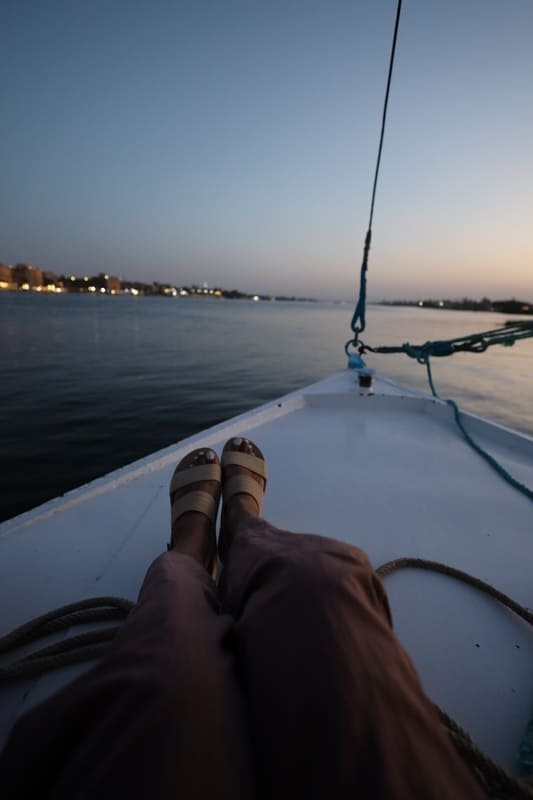
You’ll sail past colorful riverbanks, palm trees, and maybe even spot camels or villagers along the shore.
We found the experience to be one of the most relaxing parts of our trip.
Gliding along the calm waters with the sun dipping behind the palm-lined banks was the perfect way to slow down after a day of exploring.
The soft, golden light made everything feel more peaceful, and the gentle breeze was a welcome break from the daytime heat.
Chew Tip:
- Go around sunset for the best weather and views—it’s much cooler and far more scenic.
- Bring cash to tip your boat captain.
- Negotiate the price before getting on board if you’re booking in person.
How Much to Budget:
- Felucca ride: ~$5–10 USD per person for a private ride, depending on the duration and group size.
- Booking ahead: You can book online if you prefer to avoid haggling, but it will probably cost a bit more.
Final Thoughts
The Aswan Nubian Village is a cultural highlight—welcoming, colorful, and authentic.
Whether you’re wandering the markets, enjoying local dishes, or watching the sunset over the Nile, the village offers a side of Egypt you won’t find anywhere else.
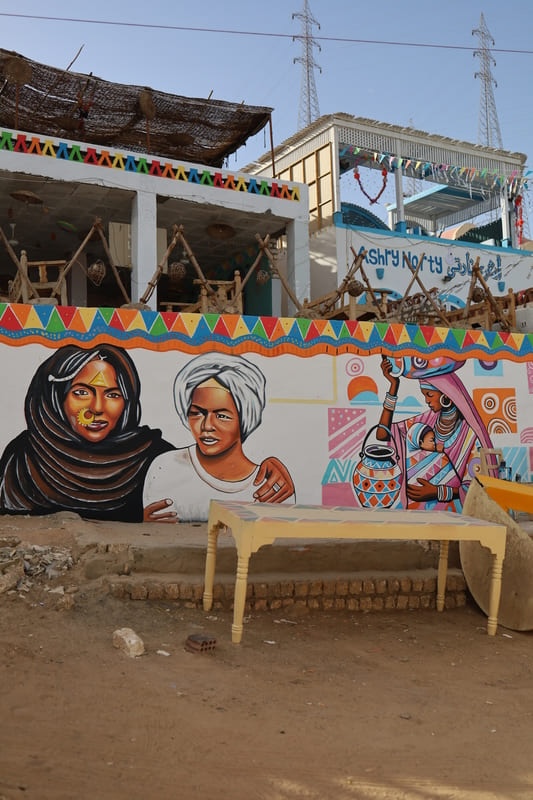
Keep planning your Egypt trip with these articles:
- Best Things to Do in Cairo
- Best Things to Do in Luxor
- Important Egypt Travel Tips
- Ultimate Egypt Itinerary
Found this article helpful? Share it!

